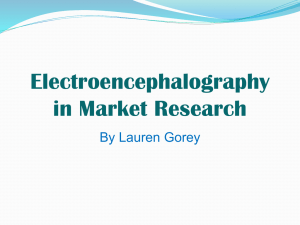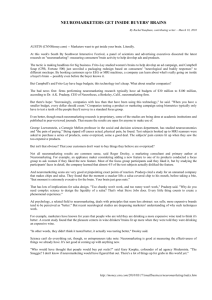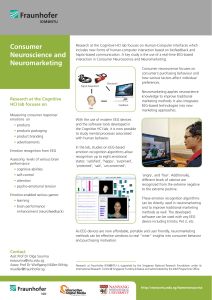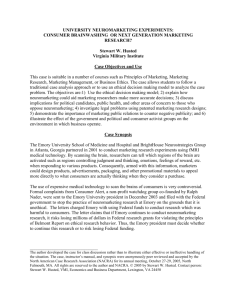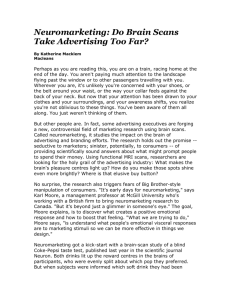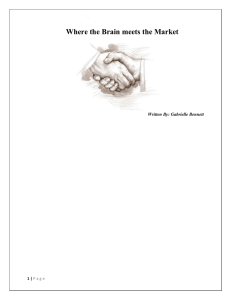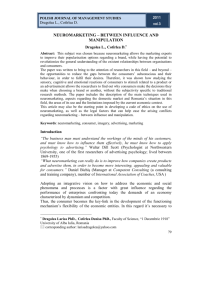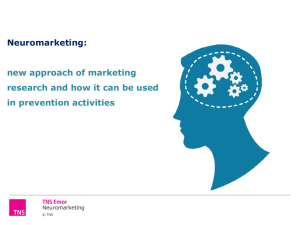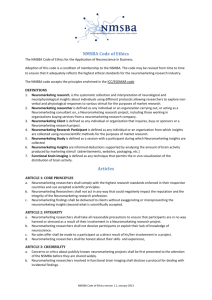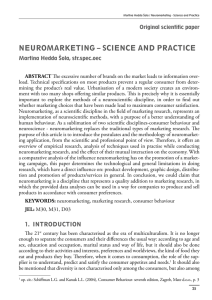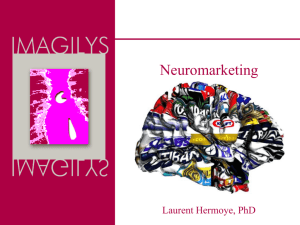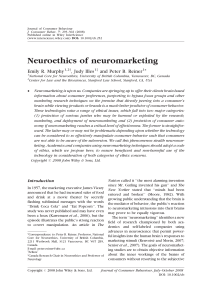1 AAB Neuromarketing article
advertisement
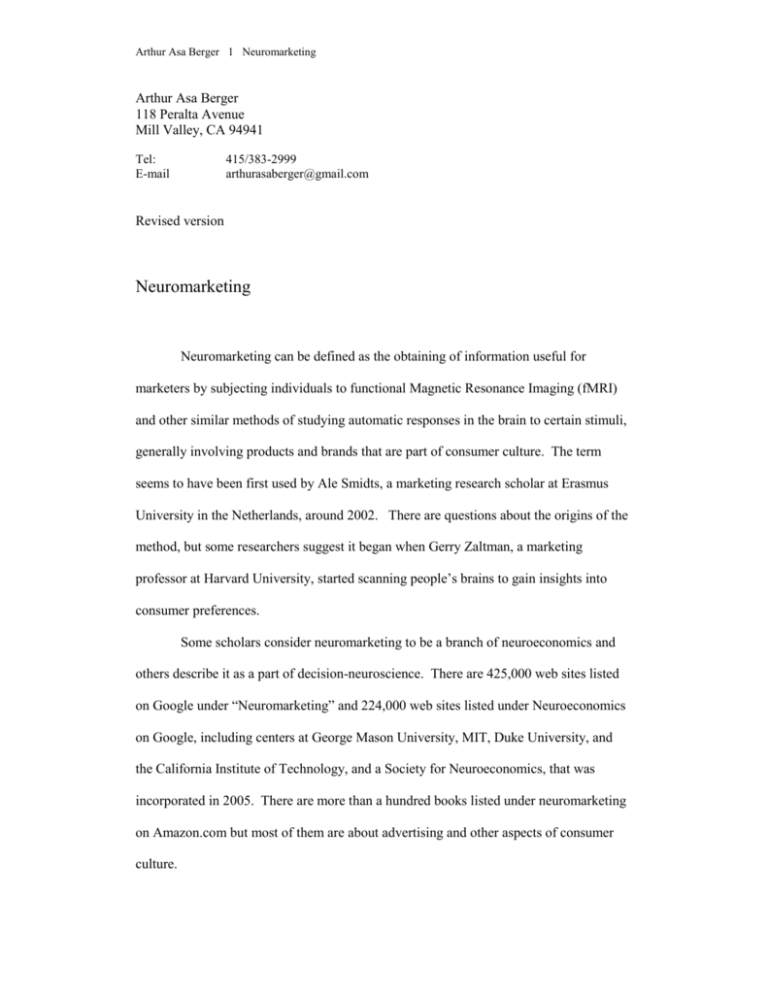
Arthur Asa Berger 1 Neuromarketing Arthur Asa Berger 118 Peralta Avenue Mill Valley, CA 94941 Tel: E-mail 415/383-2999 arthurasaberger@gmail.com Revised version Neuromarketing Neuromarketing can be defined as the obtaining of information useful for marketers by subjecting individuals to functional Magnetic Resonance Imaging (fMRI) and other similar methods of studying automatic responses in the brain to certain stimuli, generally involving products and brands that are part of consumer culture. The term seems to have been first used by Ale Smidts, a marketing research scholar at Erasmus University in the Netherlands, around 2002. There are questions about the origins of the method, but some researchers suggest it began when Gerry Zaltman, a marketing professor at Harvard University, started scanning people’s brains to gain insights into consumer preferences. Some scholars consider neuromarketing to be a branch of neuroeconomics and others describe it as a part of decision-neuroscience. There are 425,000 web sites listed on Google under “Neuromarketing” and 224,000 web sites listed under Neuroeconomics on Google, including centers at George Mason University, MIT, Duke University, and the California Institute of Technology, and a Society for Neuroeconomics, that was incorporated in 2005. There are more than a hundred books listed under neuromarketing on Amazon.com but most of them are about advertising and other aspects of consumer culture. Arthur Asa Berger 2 Neuromarketing Neuromarketing is a means of studying consumer preferences and buying patterns by examining automatic neurological responses—that is, which parts of people’s brains light up due to increased oxygenated blood flow--when they are shown images of products or other material related to consumer culture. This method avoids problems caused by asking people to verbalize their feelings about products and brands, since their responses to these questions are not always reliable. On the other hand, there is the question of how much the fMRI machines, which are noisy and which stress people being tested to some degree, may have an impact on the brain’s functioning. There is also the matter of how marketers translate the physical responses of our brains, as discovered by fMRI imagining, into campaigns and advertising that will be effective. The theory is that when we understand more about how the brain functions, and can see what responses the brain has to certain stimuli, we can use our knowledge of the emotional responses people make to images of products and brands to figure out better ways of shaping consumer decision making. An important experiment in the development of neuromarketing occurred in 2003 when professor Read Montague, director of the Human Neuroimaging Lab and the Center for Theoretical Neuroscience at Baylor College of Medicine, used fMRI to find out why Pepsi won blind taste tests but people generally said they preferred the taste of Coca-Cola. Dr. Montague discovered that the medial prefrontal cortex of people being scanned lit up brightly when they were told they were drinking Coca-Cola, due, in some measure it is assumed, to the effectiveness of Coca-Cola’s marketing and advertising. Neuromarketing techniques are now being employed in many countries. In Oxford, England, a company named Neurosense has used neuromarketing to determine how viewers respond to commercials at different times of the day. There are numerous researchers in the field, such as BrightHouse Neurostrategies Group in Atlanta, a neuromarketing consulting company in Vienna, Neuroconsult; a company in Los Angles, Arthur Asa Berger 3 Neuromarketing FKF, that uses neuromarketing to study political decision making; researchers at the Social Cognitive Neuroscience Laboratory at the California Institute of Technology; a neuroeconomics lab at Stanford; the Center for Neuroeconomics in the Netherlands; SalesBrain in San Francisco; and companies in many other countries using fMRI imaging for a variety of purposes. Neuromarketing is also a factor in political campaigns. Research has indicated that many people’s political affiliations are more or less “hard-wired” and that they do not, generally speaking, respond to logical arguments when making choices for political offices. It has also been found that parts of the brain light up differently in Democrats and Republicans when shown images of the September 11th World Trades Center disaster. Nueromarketers face the problem of how to translate the physical responses of our brains into marketing and advertising campaigns that will be effective. Just because a certain part of a person’s brain lights up dramatically when shown an image of a product or a brand doesn’t mean that person has positive feelings about it or will want to purchase that product. The Knudson study found that “specific patterns of brain activation predict purchasing,” but there are a number of variables that can adversely affect things, such as high prices. Some marketing scholars and practitioners regard neuromarketing as one more fad sweeping the industry, whose influence and impact will be short lived. Whether neuromarketing becomes an important tool in marketing (with Orwellian implications involving some kind of mind control) or is just a passing fad remains to be seen. Another problem is that neuromarketing is relatively expensive to use. Finally, there is the matter of ethical questions involved with using the kind of information obtained in fMRI studies to persuade people to purchase products and services or to vote for certain politicians or political parties by hitting their “buy buttons.” Some psychologists consider neuroeconomics and neuromarketing research to be Arthur Asa Berger 4 Neuromarketing unethical, though the American Psychological Association accepts neuromarketing research as acceptable and not something that will be detrimental to people’s well being. Bibliography Knutson, Brian, Scott Rick, G. Elliott Wimmer, Drazen Prelec, and George Loewenstein, “Neural Predictors of Purchases.” Neuron 53, 147-156. January 4, 2007. Elsevier, Inc. McCarthy, Terry. “Getting Inside Your Head.” 95-97. Time. Oct. 24, 2005. “Neuromarketing.” Wickepedia, the free encyclopedia. http://en.wickipedia.org/wiki/Neuromarketing. Renvoisé, Patrick and Christophe Morin. (2007). Neuromarketing: Understanding the “Buy Buttons” in Your Customer’s Brain. Nashville, Tenn: Thomas Nelson. Szegedy-Maszak, Marianne. “Mysteries of the Mind,” 53-61. U.S. News & World Report. Feb. 28, 2005.
